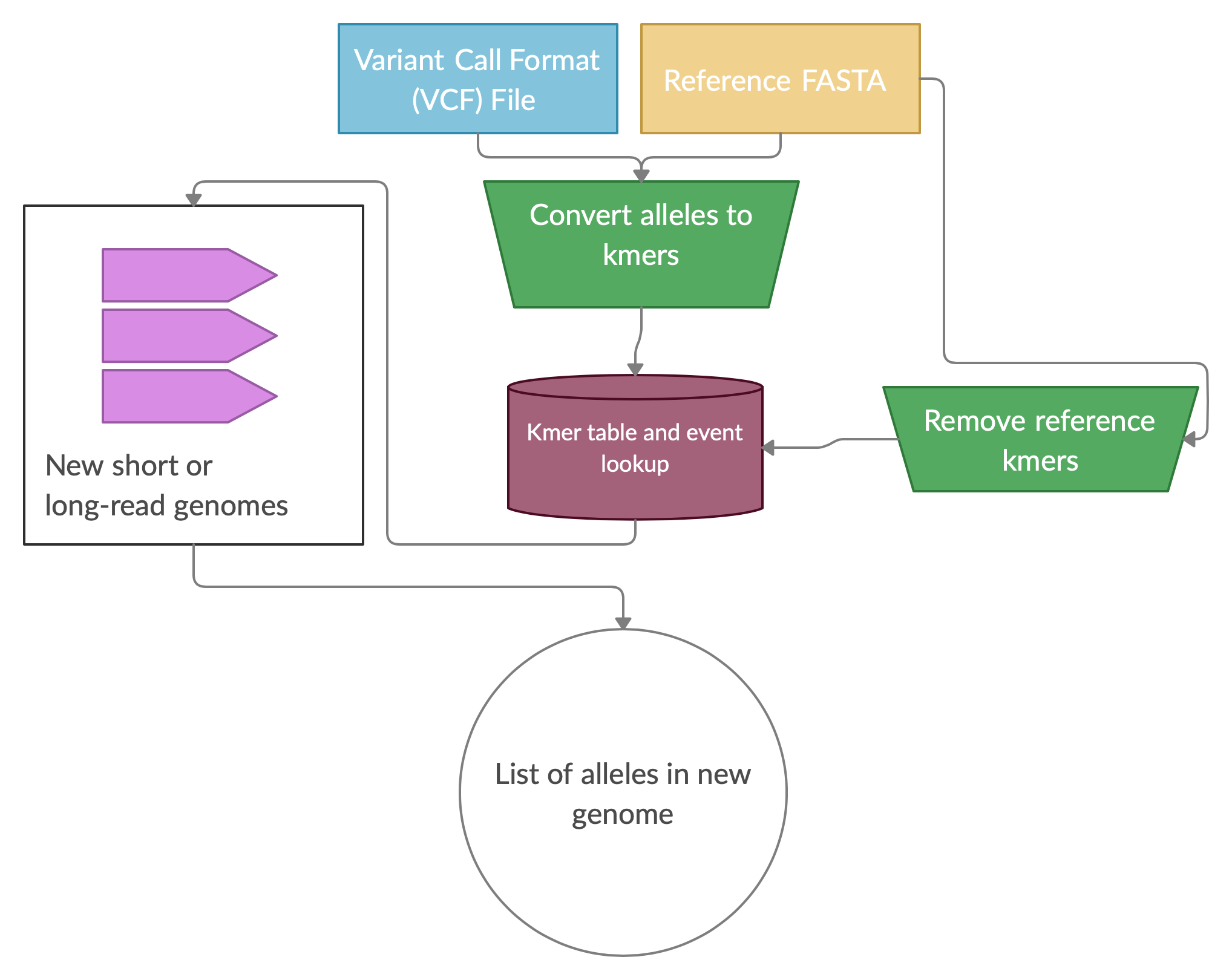DEPRICATED! Moved to : https://github.com/fritzsedlazeck/nibSV
Brent Pederson1, Christopher Dunn2, Eric Dawson3, Fritz Sedlazeck4, Peter Xie5, and Zev Kronenberg2
1 University of Utah; 2PacBio; 3Nvidia Corporation; 4Baylor College of Medicine; 5JBrowse (UC Berkeley);
Structural variation (SV) are the largest source of genetic variation within the human population. Long read DNA sequencing is becoming the preferred method for discovering structural variants. Structural variation can be longer than a short-read (<500bp) DNA trace, meaning the SV allele is not contained, which causes challenges and problems in the detection.
Long read sequencing has proven superior to identify Structural Variations in individuals. Nevertheless, it is important to obtain accurate allele frequencies of these complex alleles across a population to rank and identify potential pathogenic variations. Thus, it is important to be able to genotype SV events in a large set of previously short read based sequenced samples (e.g. 1000genomes, Topmed, CCDG, etc.). Two main approaches has been recently shown to achieve this with high accuracy even for insertions: Paragraph and VG. However, these methods still consume hours per sample and even more depending on the number of SV to be genotyped along the genome or in regions. Furthermore and maybe more crucially rely on precise breakpoints that do not change in other samples. This assumption might be flawed over repetitive regions. In addition the problem currently arises that some data sets are mapped to different genomic version than others (e.g hg19 vs. GRCH38 vs. CHM13) and will require a different VCF catalog to be genotyped.
NibblerSV can overcome these challenges. NibblerSV relies on a k-mer based strategy to identify SV breakpoints in short read data set. Due to innovative k-mer design and efficient implementation, NibblerSV is able to run on a 30x cram file within minutes with low memory requirements. Its k-mer strategy of spaced k-mers allow a relaxed constrain on the precision of the breakpoint. In addition, utilizing k-mers NibblerSV is independent of the genomic reference the short reads were aligned to and can even work on raw fastq reads. This makes NibblerSV a lightweight, scalable and easy to apply methods to identify the frequency of Structural Variatons.
Who doesn't like to nibble on SV?
NibblerSV is a light weighted framework to identify the presence and absence of Structural Variations across a large set of Illumina sequenced samples. To achieve this we take a VCF file including all the SV that should be genotyped. Next, we extract the reference and alternative allele kmers. This is done such that we include the flanking regions. Subsequently, we count the occurrence of these k-mers in the reference fasta file. This is necessary to not miscount certain k-mers. To enable large scaling of NibblerSV the results of these two steps are written into a temporary file, which is all that is needed for the actual genotyping step.
During the genotyping step NibblerSV uses the small temporary file and the bam/cram file of the sample. NibblerSV then identifies the presence /absence of the reference and alternative k-mer across the entire sample. This is very fast and requires only minimal resources of memory as the number of k-mers is limited. Once NibblerSV finished the scanning of the bam/cram file it reports out which SV have been re-identified by adding a tag in the output VCF file of this sample. The VCF per sample can then be merged to obtain population frequencies.
To run nibblerSV just execute this example which uses the test data provided. You should have a copy of GRCh38 available to run this.
./src/nibsv main -v test-data/GIAB_PBSV_TRIO_CALLS_TEST2.vcf -r hg38.fa.gz --reads-fn test-data/event_one.bam -p HG02
Full usage:
(base) ZKRONENBERG-MAC:nibSV zkronenberg$ ./src/nibsv main -h
Usage:
main [required&optional-params]
Generate a SV kmer database, and genotype new samples. If a file called "{prefix}.sv_kmers.msgpack" exists, use it. Otherwise,
generate it.
Options:
-h, --help print this cligen-erated help
--help-syntax advanced: prepend,plurals,..
-v=, --variants-fn= string REQUIRED long read VCF SV calls
-r=, --refSeq-fn= string REQUIRED reference genome FASTA, compressed OK
--reads-fn= string REQUIRED input short-reads in BAM/SAM/CRAM/FASTQ
-p=, --prefix= string "test" output prefix
-k=, --kmer-size= int 25 kmer size, for spaced seeds use <=16 otherwise <=32
-s, --spaced-seeds bool false turn on spaced seeds
--space= int 50 width between spaced kmers
-f=, --flank= int 100 number of bases on either side of ALT/REF in VCF records
-m=, --max-ref-kmer-count= uint32 0 max number of reference kmers allowed in SV event
- A Strucutural variant VCF
- An indexed FASTA file of the reference genome
- A BAM/CRAM file (new genome)
A VCF file with a tag in INFO field identifying the present/ absance for each SV.
We have tested NibblerSV on HG002 from GIAB and various other control data sets.
See also README_NIM.md
This needs to be available as a dynamically loadable library on your system.
make setup
make build
# Or for faster executable
make release
